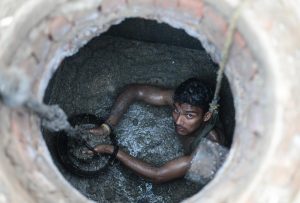
Manual scavenging has been banned in India since 1993 and is currently prohibited under the ‘The Prohibition of Employment as Manual Scavengers and their Rehabilitation Act, 2013’ (the ‘Act’). The Act mandates the provision of safety equipment and gear for workers engaged in hazardous cleaning, and also a shift towards mechanization of cleaning septic tanks, sewers, and other spaces. The Ministry of Social Justice and Empowerment (the ‘Ministry’) in a reply to the Lok Sabha on March 22, 2022, listed the measures being taken by the Government to move towards mechanization. However, financing the required equipment remains a key barrier. This blog post delves into the lack of provision of safety equipment and traces the progress of complete mechanization while focusing on certain schemes of the Government, to enable the eradication of manual scavenging.
For the last few years, while the Government has given a response of promising 100% mechanization, there is barely any provision of safety gear to workers. A 2021 report by the Ministry of Housing and Urban Affairs states that one of the key issues for sanitation workers is the lack of protective equipment which leads to regular accidents and fatalities. Paul Divakar, General Secretary of the National Campaign on Dalit Human Rights stated that the whole kit for safety gear for a worker costs not more than Rs. 5,000/- and hence costs cannot be an issue for not providing safety equipment.
The absence of the basic protective and safety equipment makes mechanization seem extremely far-fetched. Moreover, based on a report by WaterAid, it is likely that the demand for manual scavenging will go up owing to the construction of new toilets under the Swachh Bharat Mission (SBM). Though it is claimed that SBM enabled obviating manual scavenging by promoting twin-pit technology, in 2017-18, 20% of toilets had single pits and 38% had septic tanks with soaking pits, both of which require manual cleaning.
Section 33 of the Act requires the Government to promote the use of modern technology through incentives and financial assistance. Among the measures taken by the Government towards mechanization, several schemes were highlighted by the Ministry, such as the Swacchta Udyami Yojana (SUY) and the Self Employment Scheme for Rehabilitation of Manual Scavengers (SRMS) capital subsidy scheme. These schemes are being implemented by the National Safai Karamcharis Finance & Development Corporation (NSKFDC). The SUY scheme provides for concessional loans to Urban Local Bodies (ULB), sanitation workers and their dependents for the procurement of cleaning equipment, vehicles, and machinery. Further, the SRMS provides for capital subsidies upto Rs. 5 lakhs for sanitation related projects to the sanitation workers and their dependents. However, the number of workers assisted by the scheme remains to be abysmally low. For instance, since the inception of the SUY scheme in 2014, only 1800 workers have been assisted. Further, under the SRMS capital subsidy scheme which was implemented from 2020-21, only 194 workers have obtained capital subsidies for procuring sanitation related vehicles/equipment.
Several equipments and technologies have the potential to ease the work of the sanitation workers by minimizing the need for humans to enter into manholes, septic tanks, or sewers. Bandicoot is the world’s first cleaning robot that can clean any type of sewer manholes in just about 20 minutes. Sewer Croc is another robot that has a camera to identify, display the blockages, etc. and then break down and flush out the blockers in the sewer line. The impediment to employing such equipment is its cost. Bandicoot for instance costs about 39.5lakhs. Despite the need of additional financial outlays required to procure such equipment, the budget allocation for NSKFDC and SRMS in 2022 has been reduced substantially. The combined budget for NSKFDC and SRMS is only 0.7% of the total budget of the Ministry.
As stated by Bezwada Wilson, the National Convener of Safai Karamchari Andolan, the casteist mindset towards sewage cleaning has led the Government to delay modernization and mechanization of sanitation. The data above clearly indicates the need for additional funds to be allocated to NSKFDC. If the government is serious about eradicating manual scavenging and implementing the 2013 Act in essence, it is crucial to provide safety equipment and gears as mandated by law and to shift towards mechanization.
This was written by Muskan Bhuteria, a fifth year law student from Jindal Global Law School who interned with CLPR.
